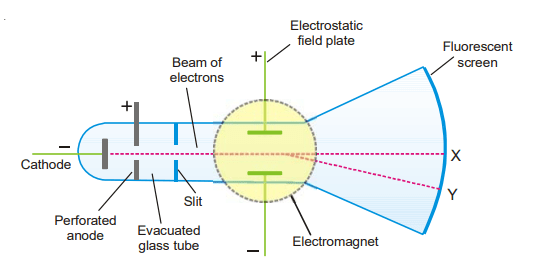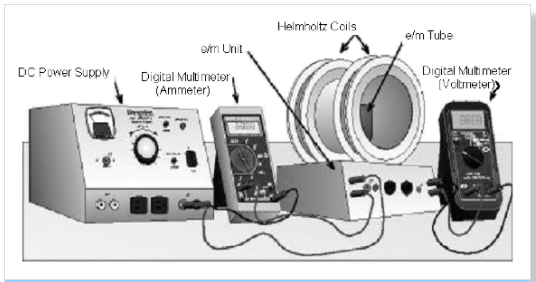Measurement of e/m for electrons: The ratio of charge to mass (e/m) for an electron was measured by J.J. Thomson (1897) using the apparatus shown in the Figure below.

On the fluorescent screen, electrons form a brilliant light spot at X. The electrons are initially deflected in a circular route by a magnetic field, while the spot is moved to Y. The radius of the circular route may be calculated using the apparatus’ dimensions, the current and number of turns in the electromagnet’s coil, and the spot’s angle of deflection. The spot is then returned to its original place using an electric field of known intensity. The velocity of the electrons may then be calculated using the strength of the electrostatic and magnetic fields.
Equating magnetic force on the electron beam to centrifugal force.
Bev =mv2 /r
where B = magnetic field strength
v = velocity of electrons
e = charge on the electron
m = mass of the electron
r = radius of the circular path of the electron in the magnetic field.
This means
e/m=v/Br ————————1
The value of r is obtained from the dimensions of the tube and the displacement of the electron spot on the fluorescent screen.
When the electrostatic field strength and magnetic field strength are counterbalanced,
Bev = Ee
where E is the strength of the electrostatic field.
Thus
v = E/B ————–2
If E and B are known, v can be calculated and on substitution in equation (1), we get the value
of e/m.
e/m=E/B2 r
All the quantities on the right side of the equation can be determined experimentally. Using this
procedure, the ratio e/m works out to be – 1.76 × 108 per gram.
or e/m for the electron = – 1.76 × 108 coulomb/g
The setup of the equipment used in this experiment is shown in the Figure below. The major items on the e/m-unit are the three-element electron tube and the Helmholtz coils. The electron tube, Helmholtz coils, and the power supplies for the tube filament and for the accelerating voltage are mounted in a single base called the e/m unit.
Controls and connectors on the front panel of this unit are (from left to right):
- Helmholtz Coil Connector: A pair of terminals that connect to an external power source and an ammeter, allowing current to flow through the coils.
- Indicator and Power Switch: Turns on and off the filament and accelerating-voltage supply.
- Adjust the focus of the electron beam to achieve the greatest possible focus.
- Accelerating Voltage Control and Push Button: The accelerating voltage may be set to any number between 45 and 135 volts with this control knob. The accelerating voltage can be supplied for a brief period of time to see the electron beam using this button.
- Accelerating Voltage/100: A pair of terminals at which 1/100th of the accelerating voltage is present—attach a 0-2 volt digital meter to read this 1/100th of the accelerating voltage.

Make sure check our amazing article: Discovery of electron